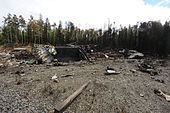Summary Stall, Pilot error Survivors 0 Date 28 July 2010 Total fatalities 4 (all) Passenger count 0 | Passengers 0 Registration 00-0173 Operator United States Air Force Survivor 0 Crew count 4 | |
 | ||
Site Elmendorf Air Force Base, Alaska, U.S. Aircraft type Boeing C-17 Globemaster III Similar 1952 Mount Gannett, 2010 Alaska Turbo Ott, 2010 Air Service Berlin Do, Zalingei Tarco Airlines A, Tajik National Guard hel | ||
2010 alaska c 17 crash full video
On July 28, 2010, a U.S. Air Force transport plane crashed at Elmendorf Air Force Base in Alaska, resulting in the death of all four crew members aboard. The aircraft involved was a Boeing C-17 Globemaster III (tail number 00-0173) and the crash was the first fatal C-17 flight mishap. The crew were practicing for Elmendorf's Arctic Thunder Air Show, which took place three days later.
Contents
- 2010 alaska c 17 crash full video
- 2010 alaska c 17 crash
- Aircraft
- Flight
- Accident and aftermath
- Investigation and reactions
- References
2010 alaska c 17 crash
Aircraft
The aircraft was a four-engined C-17 Globemaster III built by Boeing. It belonged to the 3rd Wing (3 WG) and operated jointly with the 176th Wing (176 WG) at Elmendorf AFB, located near downtown Anchorage. The aircraft had Air Force serial number "00-0173" and was named Spirit of the Aleutians.
The U.S. Air Force has 199 C-17s in service with the active Air Force, Air Force Reserve, and Air National Guard, with the type being based at Elmendorf since June 2007. At the time of the crash, the base had eight of the aircraft, operated jointly by an active duty Air Force organization, the 3rd Wing's 517th Airlift Squadron; and an Alaska Air National Guard unit, the 176th Wing's 249th Airlift Squadron. The mishap was the first fatal crash of a C-17.
Flight
At the time of the crash, the crew had been conducting a local training flight in preparation for the upcoming Arctic Thunder Air Show, to be held at the Elmendorf base from July 31 to August 1. The C-17 is commonly featured in US air shows, highlighting its short takeoff and landing capability. The plane had flown earlier that day with a different crew.
Accident and aftermath
On July 28, 2010, at approximately 6:22 p.m. Alaska Daylight Time (UTC-8), the C-17 took off from Runway 06 at Elmendorf Air Force Base to practice maneuvers for the upcoming Arctic Thunder Air Show. After the initial climb followed by a left turn, the pilot executed an aggressive right turn. As the aircraft banked, the stall warning system activated to alert the crew of an impending stall. Instead of implementing stall recovery procedures, the pilot continued the turn as planned, and the aircraft entered a stall from which recovery was not possible. The plane crashed and exploded in a fireball about two miles from the airfield.
Anchorage Fire Department Captain Bryan Grella described how a fireball extended to around 750 feet (230 m) into the air, an estimated 2 miles (3.2 km) from Anchorage. Debris from the crash was spread along 200 feet (61 m) of the Alaska Railroad tracks which carry passenger and freight trains daily through the base area, north to Wasilla, although no trains were scheduled to be passing through at the time of the crash.
The crash killed all four crew members aboard: Majors Michael Freyholtz and Aaron Malone, pilots assigned to the Alaska Air National Guard's 249th Airlift Squadron; Captain Jeffrey Hill, a pilot assigned to Elmendorf's active duty Air Force's 517th Airlift Squadron; and Senior Master Sergeant Thomas E. Cicardo, a loadmaster of the Alaska Air National Guard's 249th Airlift Squadron.
Track repairs to the nearby railroad caused freight services to be suspended, and passenger services to be diverted by bus. The air show went ahead as planned as a tribute to the four dead airmen.
Investigation and reactions
The investigation report into the crash was released on December 13, 2010. It blamed pilot error, stating that the pilot's overconfidence in executing an aggressive right-turn maneuver led to a low-altitude stall and subsequent crash, despite the warnings correctly provided by the aircraft's stall-warning system, to which neither the pilot nor any other crew member responded effectively.
As noted by several aviation commentators, the crash presented significant similarities with the 1994 crash of a B-52 bomber at Fairchild Air Force Base, Washington. On both occasions, the local USAF's chain of command apparently failed to prevent the pilots involved from developing deliberately unsafe flying practices for aerial displays of large aircraft.
